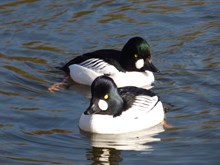31 March, 2022
Visitors asked to avoid water sports at Loch Kinord to protect birds
NatureScot is asking people visiting the Muir of Dinnet National Nature Reserve – which receives about 80,000 visitors a year – to stay off Loch Kinord at this sensitive time of year for breeding birds.
To avoid disturbing birds at this internationally important site for nature, people are being urged to stay off the water until after the 31 August, when the bird breeding season is over.
There has been a sharp rise in the number of people going out on the water in canoes, kayaks, inflatables and paddle-boards. Human activity on this small loch can disturb protected wildfowl like goldeneye, a globally threated species which has suffered severe population declines, and may lead to ducklings becoming separated from their parents and dying.
Monitoring data shows that early morning bird counts on the loch are significantly higher than those taken later in the day when visitors are present on the water. Following discussions with stakeholders, including recreational users, expert advice from ornithologists and support from Cairngorms National Park as the access authority, changes to the water access guidance were introduced last summer and this made a positive difference.
Gavin Clark, Tayside & Grampians operations manager, said:
“We want everyone to have a wonderful time visiting the reserve, but we're asking people to remember that Muir of Dinnet is first and foremost a nature reserve, where we protect wildlife while balancing visitor needs.
“Individually, someone going out on the water may not be aware of any problem, but put that together with lots of other people doing the same thing and over time it adds up to a significant disturbance problem for the birds.
“Our evidence shows that by limiting water access we reduce disturbance and help to conserve important bird species. This is an important step to enhance our habitats to allow our water birds the very best chance to pair up and raise their young.
“We hope our visitors will understand and follow this guidance throughout the breeding bird season, and we thank people for enjoying our reserve responsibly.”
There are signs placed at all main entry points to the nature reserve, as well as information on NatureScot’s website explaining the water access guidance.
A similar request has been in place since 2009 at a second, smaller loch on the reserve, Loch Davan, because of bird disturbance and the potential for damage to sensitive habitats.
NatureScot is also asking visitors to be aware of wildlife and to be alert when walking dogs in nature reserves, or anywhere in the countryside. Keep dogs at heel or on a lead in places such as moorland, forests, grasslands and shores to avoid disturbing birds that nest on or near the ground. For more information on responsible outdoor access in Scotland, see www.outdooraccess-scotland.scot.
Contact information
- Name
- NatureScot Media
- Telephone
- 0131 316 2655
- media@nature.scot
Notes to editors
Muir of Dinnet is a Site of Special Scientific Interest for its breeding bird and freshwater interests. It is also a Special Protection Area for its non-breeding wildfowl assemblage and a Special Area of Conservation for otter. All wild birds and their nests are protected under the Wildlife and Countryside Act, and some species such as goldeneye, which is present on the reserve, are subject to additional protection from intentional or reckless disturbance. The assemblage of breeding birds SSSI feature regularly includes species such as great-crested and little grebes, mute swan, water rail, spotted crake and sedge warbler, along with wigeon, goosander and goldeneye. In addition, the lochs are also an important feeding site for osprey, which nest elsewhere in Deeside.
For nature reserves, the Scottish Outdoor Access Code states:
Access rights extend to these places but remember that they are carefully managed for nature conservation and to safeguard rare animals and plants. Take care to avoid damaging the site or disturbing its wildlife, or interfering with its management or enjoyment by others. Depending on your activity, you might be requested to follow a specific route or to avoid exercising access rights in a specific area. Following such local guidance can help to safeguard the natural heritage of these areas.
For information on visiting the Muir of Dinnet NNR see www.nature.scot/enjoying-outdoors/scotlands-national-nature-reserves/muir-dinnet-nnr/muir-dinnet-nnr-visiting-reserve.
There are 43 National Nature Reserves in Scotland. These are special places that look after some of the best of Scotland’s nature on behalf of everyone who lives or visits Scotland, and they provide unique opportunities to visit, enjoy and learn more about Scotland’s nature. For more information, see see www.nature.scot/enjoying-outdoors/scotlands-national-nature-reserves
NatureScot is Scotland's nature agency. We work to enhance our natural environment in Scotland and inspire everyone to care more about it. Our priority is a nature-rich future for Scotland and an effective response to the climate emergency. For more information, visit our website at www.nature.scot or follow us on X at https://x.com/NatureScot
’S e NatureScot buidheann nàdair na h-Alba. Bidh sinn a’ neartachadh àrainneachd na h-Alba agus a’ brosnachadh dhaoine gu barrachd suim a chur ann an nàdar. Tha e mar phrìomhachas againn gum bi nàdar na h-Alba beairteach agus gun dèilig sinn gu h-èifeachdach le èiginn na gnàth-shìde. Tha an tuilleadh fiosrachaidh aig www.nature.scot no air X aig https://x.com/NatureScot

